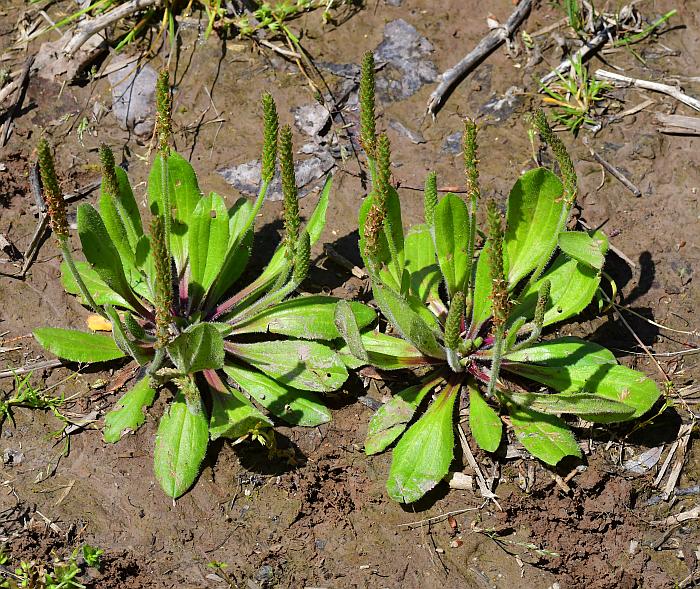Plantago virginica L.
Hoary Plantain

Native
CC = 1
CW = 5
MOC = 79
© SRTurner
Plantago virginica L.Hoary Plantain | |
 |
Native CC = 1 CW = 5 MOC = 79 |
© SRTurner |
|
Family - Plantaginaceae Habit - Taprooted annual forb.
Stems - Aerial stems absent or very short. Leaves - In a dense basal rosette, the larger leaves sometimes with a petiole 1-6 cm long, usually pale at the base, spreading to ascending. Blades 1-10 cm long, 4-35 mm wide, narrowly to broadly oblanceolate, obovate, or spatulate, angled to a bluntly or sharply pointed tip, tapered at the base, the margins entire or sparsely and inconspicuously toothed, hairy, the surfaces moderately pubescent with more or less spreading hairs, appearing green to yellowish green or pale green, with 3-7 parallel main veins all arising from the leaf base. Petioles typically purple at the base.
Inflorescences - 1 to several per plant, terminal, elongate spikes, 3-15 cm long, 5-9 mm in diameter, densely flowered (the axis not visible between the flowers), the scape 2-15 cm long, spreading-hairy, the axis solid. Bracts 1.0-2.5 mm long, similar in length, mostly shorter than the flowers, broadly lanceolate to ovate, with narrow to broad, translucent margins and a thickened, bluntly keeled, green midnerve, rounded or angled to a bluntly pointed tip, hairy, at least along the midnerve. Cleistogamous flowers usually abundant.
Flowers - Calyces deeply 4-lobed, 1.5-2.7 mm long, slightly zygomorphic, oblong-obovate, rounded at the tip, the keel hairy, the relatively broad margins thin and papery. Corollas slightly zygomorphic, the 4 lobes 0.8-2.3 mm long, narrowly to broadly lanceolate with a shallowly cordate base, sharply pointed at the tip, the margins entire, tan and membranous, lighter at the base, the upper lobe slightly shorter than the others, all of the other lobes erect and overlapping or spreading during flowering, becoming erect and convergent in fruit. Stamens 4, alternating with the corolla lobes, erect to spreading, well exserted. Filaments translucent, glabrous, 3-5 mm long. Anthers purple when fresh, 1 mm long. Ovary superior, green, glabrous, globose, 0.7 mm in diameter. Style 1, pubescent, 4-5 mm long, exserted.
Fruits - Membranous capsules 2.5-3.8 mm long, narrowly ellipsoid, circumscissile below the midpoint. Seeds usually 2 per fruit, 1.4-2.0 mm long, narrowly ovate, the surface relatively deeply concave on 1 side, otherwise finely pitted or finely wrinkled to nearly smooth, yellowish brown to black, dull. Flowering - April - June. Habitat - Glades, prairies, savannas, streambanks, pond margins, bluffs, pastures, fields, railroads, roadsides, open disturbed areas. Origin - Native to the U.S. Lookalikes - Other species of Plantago, esp. P. rugelii, P. major, P. rhodosperma. Other info. - This small native species is often ignored due to its weedy aspect. It is found throughout Missouri, and ranges across most of the eastern U.S. and parts of the southwest. It is quite variable and can be mistaken for other plantains. Traits to examine include the relatively thick, densely hairy inflorescence stalks, cylindrical inflorescences, and hairy bracts. The leaves are typically pale green in color, and are most often noticeably hairy, unlike those of P. rugelii or P. major. Photographs taken in Brown Summit, NC., 4-16-03 (DETenaglia); also near Labadie, Franklin County, MO, 4-25-2021 (SRTurner). |